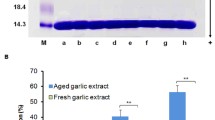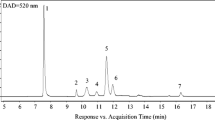Abstract
Human LDL were used to study the protective action of four organosulfur compounds (diallyl sulfide, DAS; diallyl disulfide, DADS; S-ethylcysteine, SEC; N-acetylcysteine, NAC) derived from garlic against oxidation and glycation. The four organosulfur compounds significantly inhibited superoxide production by xanthine-xanthine oxidase (P<0.05) and showed marked copper-chelating capability. DAS and DADS exhibited greater antioxidant activities against copper- and amphotericin B-induced LDL oxidation (P<0.05) than SEC and NAC. However, SEC and NAC were more effective in sparing LDL α-tocopherol (P<0.05). When oxidation was minimized, SEC was the most powerful agent against LDL glycation (P<0.05); however, DADS was superior to other agents in suppressing both oxidation and glycation when LDL oxidation occurred simultaneously with glycation. These results suggest that the four organosulfur compounds derived from garlic are potent agents for protecting LDL against oxidation and glycation, and that they may benefit patients with diabetes mellitus or cardiovascular diseases by preventing complications.
Similar content being viewed by others
Abbreviations
- AmB:
-
amphotericin B
- CD:
-
conjugated diene
- DADS:
-
diallyl disulfide
- DAS:
-
diallyl sulfide
- MDA:
-
malondialdehyde
- NAC:
-
N-acetylcysteine
- SEC:
-
S-ethylcysteine
- TBA:
-
thiobarbituric acid
References
Lyons, T.J. (1993) Glycation and Oxidation: A Role in the Pathogenesis of Atherosclerosis, Am. J. Cardiol. 71, 26B-31B.
Hunt, J.V., and Wolff, S.P. (1991) Oxidative Glycation and Free Radical Production, a Causal Mechanism of Diabetic Complications, Free Rad. Res. Commun. 12, 115–123.
Li, D., Devaraj, S., Fuller, C., Bucala, R., and Jialal, I. (1996) Effect of α-Tocopherol on LDL Oxidation and Glycation: In vitro and in vivo Studies, J. Lipid Res. 37, 1978–1986.
Picard, S. (1995) Lipoprotein Glyco-oxidation, Diabete Metab. 21, 89–94.
Albertini, R., Moratti, R., and De Luca, G. (2002) Oxidation of Low-Density Lipoprotein in Atherosclerosis from Basic Biochemistry to Clinical Studies, Curr. Mol. Med. 2, 579–592.
Hunt, J.V., Bottoms, M.A., Clare, K., Skamarauskas, J.T., and Mitchinson, M.J. (1994) Glucose Oxidation and Low Density Lipoprotein-Induced Macrophage Ceroid Accumulation: Possible Implications for Diabetic Atherosclerosis, Biochem. J. 300, 243–249.
Dwivedi, C., Abu-Ghazaleh, A., and Guenther, J. (1996) Effects of Diallyl Sulfide and Diallyl Disulfide on Cisplatin-Induced Changes in Glutathione and Glutathione-S-transferase Activity, Anti-Cancer Drugs 7, 792–794.
Wu, C.C., Sheen, L.Y., Chen, H.W., Tsai, S.J., and Lii, C.K. (2001) Effects of Organosulfur Compounds from Garlic Oil on the Antioxidation System in Rat Liver and Red Blood Cells, Food Chem. Toxicol. 39, 563–569.
O'Gara, E.A., Hill, D.J., and Maslin, D.J. (2000) Activities of Garlic Oil, Garlic Powder and Their Diallyl Constituents Against Helicobacter pylori, Appl. Environ. Microbiol. 66, 2269–2273.
Tsao, S.M., and Yin, M.C. (2001) In vitro Activity of Garlic Oil and Four Diallyl Sulphides Against Antibiotic-Resistant Pseudomonas aeruginosa and Klebsiella pneumoniae, J. Antimicrob. Chemother. 47, 665–670.
Yin, M.C., Huang, S.W., and Chan, K.C. (2002) Non-enzymatic Antioxidant Activity of Four Organosulfur Compounds Derived from Garlic, J. Agric. Food. Chem. 50, 6143–6147.
Tsao, S.M., and Yin, M.C. (2001) In-vitro Antimicrobial Activity of Four Diallyl Sulphides Occurring Naturally in Garlic and Chinese Leek Oils, J. Med. Microbiol. 50, 646–649.
Barwicz, J., Dumont, I., Ouellet, C., and Gruda, I. (1998) Amphotericin B Toxicity as Related to the Formation of Oxidatively Modified Low Density Lipoproteins, Biospectroscopy 4, 135–144.
Wasan, K.M., Kennedy, A.L., Cassidy, S.M., Ramaswamy, M., Holtorf, L., Chou, J.W., and Pritchard, P.H. (1998). Pharmacokinetics, Distribution in Serum Lipoproteins and Tissues and Renal Toxicities of Amphotericin B and Amphotericin B Lipid Complex in a Hypercholesterolemic Rabbit Model: Single-Dose-Studies, Antimicrob. Agents Chemother. 42, 3146–3152.
Barwicz, J., Gruda, I., and Tancrede, P. (2000) A Kinetic Study of the Oxidation Effects of Amphotericin B on Human Low Density Lipoproteins, FEBS Lett. 465, 83–86.
Nourooz-Zadeh, J., Tajaddini-Sarmadi, J., Ling, K.L., and Wolff, S.P. (1996) Low-Density Lipoprotein Is the Major Carrier of Lipid Hydroperoxides in Plasma, Biochem. J. 313, 781–786.
Lowry, O.H., Rosebrough, N.J., Farr, A.L., and Randall, R.J. (1951) Protein Measurement with Folin Phenol Reagent, J. Biol. Chem. 193, 265–275.
Palozza, P., and Krinsky, N.I. (1992) Effects of β-Carotene and α-Tocopherol on Radical Initiated Peroxidation of Microsomes, Free Radic. Biol. Med. 13, 127–136.
Dillon, S.A., Burmi, R.S., Lowe, G.M., Billington, D., and Rahman, K. (2003) Antioxidant Properties of Aged Garlic Extract: An in vitro Study Incorporating Human Low Density Lipoprotein, Life Sci. 72, 1583–1594.
Lawson, L.D., Wang, Z.J., and Hughes, B.G. (1991) Identification and HPLC Quantification of the Sulfides and Dialk(en)yl Thiosulfides in Commercial Garlic Products, Planta Med. 57, 363–370.
Jain, S.K., and Palmer, M. (1997) The Effect of Oxygen Radical Metabolites and Vitamin E on Glycosylation of Proteins, Free Radic. Biol. Med. 22, 593–596.
Esterbauer, H., Striegl, G., Puhl, H., and Rotheneder, M. (1989) Continuous Monitoring of in vitro Oxidation of Human Low Density Lipoprotein, Free Radic. Res. Commun. 6, 67–75.
Duell, P.B., Oram, J.F., and Biermann, E.L. (1990) Nonenzymatic Glycation of HDL Resulting in Inhibition of High-Affinity Binding to Cultured Human Fibroblasts, Diabetes 39, 1257–1263.
SAS, SAS/STAT User's Guide, version 6, Statistical Analysis System Institute, Cary, NC, 1990.
Lau, B.H.S. (2001) Suppression of LDL Oxidation by Garlic, J. Nutr. 131, 985s-988s.
Phelps, S., and Harris, W.S. (1993) Garlic Supplementation and Lipoprotein Oxidation Susceptibility, Lipids 28, 475–477.
Lynch, S.M., and Frei, B. (1993) Mechanisms of Copper- and Iron Dependent Oxidative Modification of Human Low Density Lipoprotein, J. Lipid Res. 34, 1745–1753.
Swain, J., and Gutteridge, J.M. (1995) Prooxidant Iron and Copper, with Ferroxidase and Xanthine Oxidase Activities in Human Atherosclerotic Material, FEBS Letters 368, 513–515.
Avato, P., Tursil, E., Vitali, C., Miccolis, V., and Candido, V. (2000) Allylsulfide Constituents of Garlic Volatile Oil as Antimicrobial Agents, Phytomedicine 7, 239–243.
Moro, E., Alessandrini, P., Zambon, C., Pianetti, S., Pais, M., Cazzolato, G., and Bon, G.B. (1999) Is Glycation of Low Density Lipoproteins in Patients with Type 2 Diabetes Mellitus a LDL Pre-oxidative Condition? Diabet. Med. 16, 663–669.
Menzel, E.J., Sobal, G., and Staudinger, A. (1997) The Role of Oxidative Stress in the Long-Term Glycation of LDL, Biofactors 6, 111–124.
Nakayama, M., Izumi, G., Nemoto, Y., Shibata, K., Hasegawa, T., Numata, M., Wang, K., Kawaguchi, Y., and Hosoya, T. (1999) Suppression of Nɛ-(Carboxymethyl)lysine Generation by the Antioxidant N-Acetyl Cysteine, Perit. Dial. Int. 19, 207–210.
Author information
Authors and Affiliations
Corresponding author
About this article
Cite this article
Ou, Cc., Tsao, Sm., Lin, Mc. et al. Protective action on human LDL against oxidation and glycation by four organosulfur compounds derived from garlic. Lipids 38, 219–224 (2003). https://doi.org/10.1007/s11745-003-1054-4
Received:
Revised:
Accepted:
Issue Date:
DOI: https://doi.org/10.1007/s11745-003-1054-4




